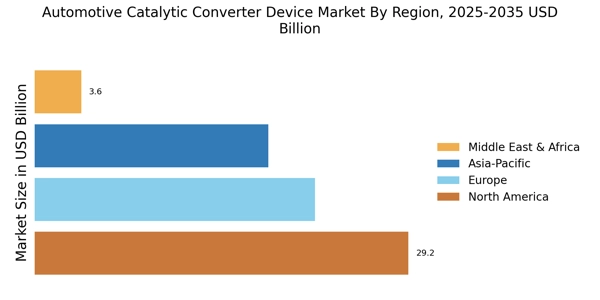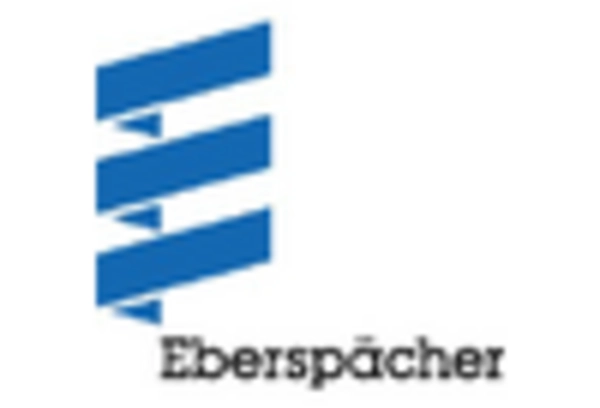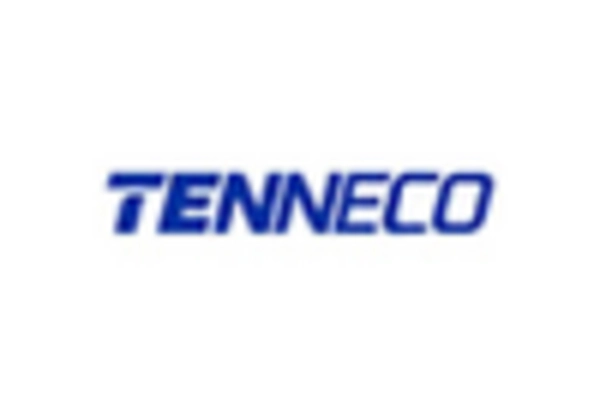Expansion of Aftermarket Services
The expansion of aftermarket services is emerging as a significant driver for the Automotive Catalytic Converter Device Market. As vehicles age, the need for replacement and repair of catalytic converters becomes more pronounced. This trend is particularly relevant in regions with a high number of older vehicles still in operation. Market analysis suggests that the aftermarket segment for catalytic converters is expected to grow substantially, driven by the increasing awareness of the importance of maintaining emission control systems. Additionally, the rise of e-commerce platforms has made it easier for consumers to access replacement parts, further fueling this growth. As a result, the Automotive Catalytic Converter Device Market is likely to benefit from the expanding aftermarket services, creating new opportunities for manufacturers and suppliers.
Rising Vehicle Production and Sales
The Automotive Catalytic Converter Device Market is poised for growth due to the rising production and sales of vehicles across various segments. As economies recover and consumer confidence improves, the demand for personal and commercial vehicles is on the rise. According to recent data, vehicle production is projected to reach over 100 million units annually by 2026, which directly correlates with an increased need for catalytic converters. This surge in vehicle manufacturing necessitates the integration of efficient emission control systems, thereby propelling the Automotive Catalytic Converter Device Market forward. Furthermore, the growing popularity of electric vehicles, which still require catalytic converters for hybrid models, adds another layer of complexity and opportunity for market players.
Growing Awareness of Environmental Issues
The growing awareness of environmental issues among consumers and policymakers is a pivotal driver for the Automotive Catalytic Converter Device Market. As public concern regarding air quality and climate change intensifies, there is a heightened demand for vehicles equipped with effective emission control systems. This shift in consumer preferences is prompting automakers to prioritize the integration of advanced catalytic converters in their vehicles. Market data indicates that consumers are increasingly willing to pay a premium for vehicles that demonstrate lower emissions and better fuel efficiency. Consequently, this trend is likely to bolster the Automotive Catalytic Converter Device Market, as manufacturers respond to consumer demands by enhancing their product offerings and investing in cleaner technologies.
Regulatory Compliance and Emission Standards
The Automotive Catalytic Converter Device Market is significantly influenced by stringent regulatory compliance and emission standards imposed by various governments. These regulations aim to reduce harmful emissions from vehicles, thereby promoting cleaner air and environmental sustainability. As a result, manufacturers are compelled to innovate and enhance their catalytic converter technologies to meet these standards. For instance, the introduction of Euro 6 standards in Europe has led to a marked increase in demand for advanced catalytic converters. This trend is expected to continue, as more regions adopt similar regulations, driving growth in the Automotive Catalytic Converter Device Market. The need for compliance not only boosts sales but also encourages research and development in catalytic converter technologies, fostering a competitive market landscape.
Technological Advancements in Catalytic Converter Design
Technological advancements play a crucial role in shaping the Automotive Catalytic Converter Device Market. Innovations such as the development of more efficient catalysts, improved substrate materials, and enhanced manufacturing processes are driving the market. For instance, the introduction of palladium and rhodium-based catalysts has shown to significantly improve the efficiency of emission reduction. Additionally, advancements in 3D printing technology are enabling manufacturers to create more complex and efficient designs, which can lead to better performance and lower costs. As these technologies continue to evolve, they are likely to attract investments and stimulate growth within the Automotive Catalytic Converter Device Market, as companies strive to stay competitive and meet the ever-increasing demands for cleaner emissions.


















Leave a Comment